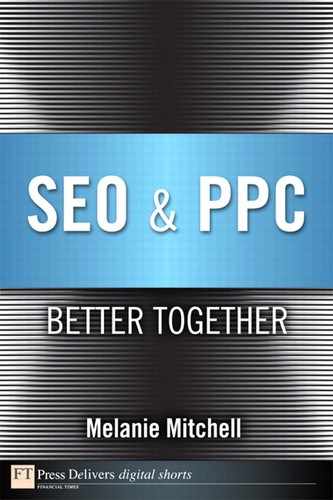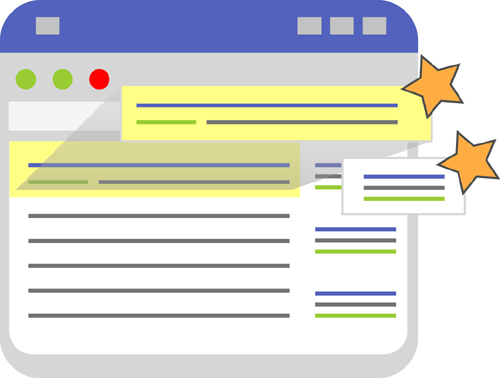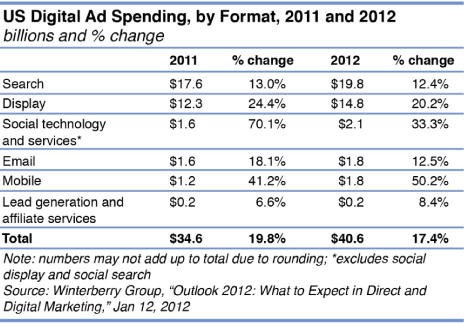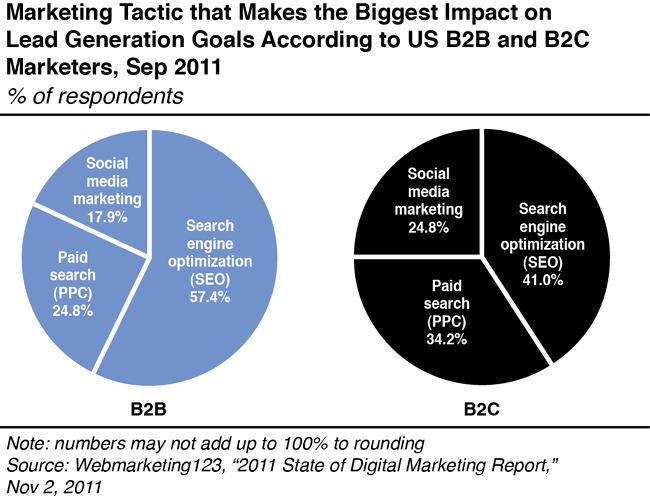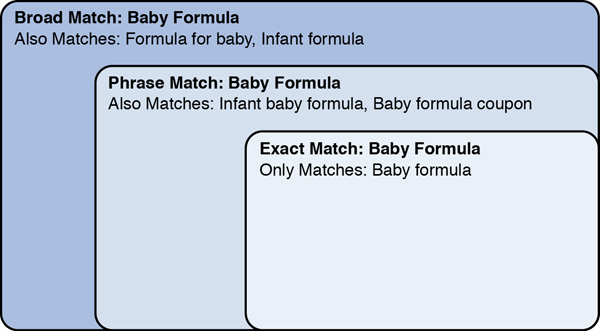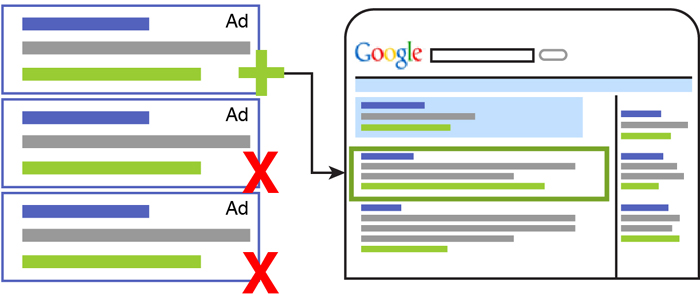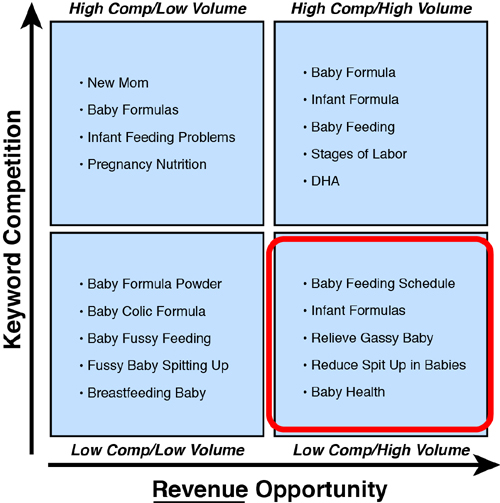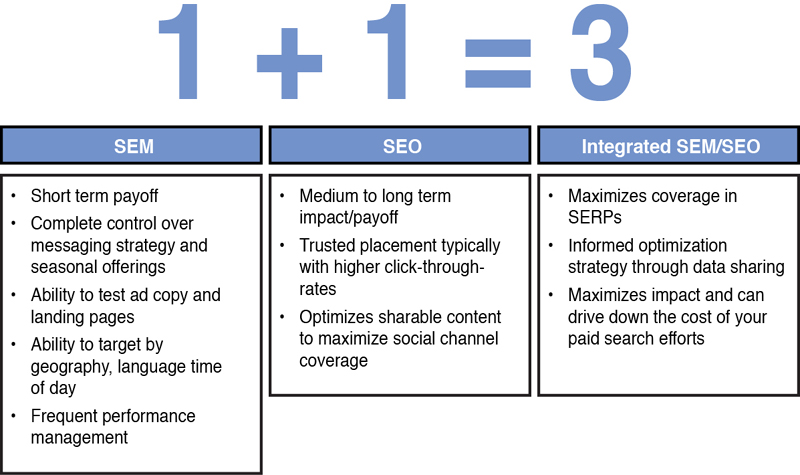SEO & PPC: Better Together
Search engine marketing, or SEM, is a form of digital marketing that seeks to promote web sites by increasing their visibility in search engine result pages (SERPs) through the organic search listings (also referred to as natural search or SEO or Search Engine Optimization), paid search listings (also referred to as PPC or Pay Per Click) and also through contextual advertising (also referred to as content targeting or in-text advertising).
Search engine marketing is constantly changing and it can be confusing, especially when getting started. While there are several forms of search engine marketing, there are typically two paths where most marketers spend their time and budgets. Those are paid search and organic search.
Paid Search
Paid search marketing is the process of gaining traffic by purchasing ads on search engines. It is sometimes referred to as CPC (cost-per-click) marketing or PPC (pay-per-click) marketing. Unlike some digital advertising where you pay for impressions, an impression is considered a page view; with PPC search, you only pay if your ad is clicked on.
In a search engine, the paid search ads are usually found at the top, bottom, and right-hand side of the search engine results page, often denoted by “sponsored listings” or “ads” (as shown in Figure 1).
Figure 1. Highlighted example of where paid search ads are typically located within the SERP
Paid search marketing continues to be the largest investment area for digital advertising (as shown in Figure 2) mainly due to its targeted nature and because it can be tracked from click to conversion.
Figure 2. Paid search 2012 spending expected to reach $19.8B, up 12.4% YOY with no slowdown in sight
Organic Search
Organic search are the listings that are not paid for by advertisers. These listings are determined by the search engines’ algorithms for finding, sorting, and ranking pages based on relevancy. To increase visibility in organic search, people optimize their web pages (called search engine optimization or SEO).
It is important to understand where you should focus your time and efforts for long term gain, since time is clearly better spent on a more balanced SEO approach than trying to game the system with spam tactics.
When you break it down, the attributes considered “quality” by a search engine are fairly obvious:
• The page is relevant to the keyword(s) being searched for.
• The page has good, useful content.
• The page is considered an authority about its topic.
• The page doesn’t have a bunch of broken links.
• The page loads quickly.
Search marketing has long been a primary source from which companies generate leads. According to September 2011 data from Webmarketing123, 82.2% of B2B marketers and 75% of B2C U.S. marketers said search-related tactics including paid search and SEO were top online marketing tactics for generating leads. SEO continues to be the most impactful source when it comes to generating these leads (see Figure 3).
Figure 3. SEO continues to be a top source for generating leads for B2B and B2C
Lead generation helps companies focus on identifying new prospects with the goal of converting them into new customers. For companies with longer sales cycles, often those selling B2B or high-value B2C products, lead generation is essential to keep the sales pipeline continually stocked.
SEO Versus PPC?
When it comes to SEO and PPC marketing, there are pros and cons to both. Looking at digital spend data or lead generation data by itself doesn’t tell the full story of where it makes sense for you to focus your efforts or why. The question then becomes why focus on one over the other or does it make sense to do a bit of both? Before we jump into the benefits of SEO and PPC working better together, let’s explore the advantages of each.
Why PPC?
Paid search or pay-per-click is what it sounds like—you pay the search engine when your ad is clicked on.
There are several advantages to running a paid search program, such as:
• You show your new messages immediately by setting up a campaign as your campaign(s) typically go live the same day you set them up.
• This can be good for increased visibility if your organic search ranking is poor or you have a limited time offer or special promotions you want to advertise, or you want to control any negative news that may be out there by taking potential customers to a landing page to provide your point of view.
• You stand out to capture the attention of new customers by targeting keywords you may not be easily found under in organic search or set targeting to specific regional or geographic locations specific to where your business serves and/or delivers.
• Geographic targeting can be especially helpful if you have a targeted marketplace (for example, a particular country, intercontinental U.S., or a particular state/city/county).
• You connect searchers directly from your search ad to the most relevant landing page.
• With paid search, you control where you are directing traffic at a keyword level and what landing page serves you best and is most relevant to the search query.
• Searchers use both brand and non-brand terms to find information.
• Most brands are going to win on ranking well in organic search for their brand terms, but depending on where people are in their journey to find information, they may start with more generic search terms at first. Keep in mind that if they don’t find your listing or ads in generic searches, they may not be aware that you also offer what they are looking for, whether it is a product or information.
• Driving traffic numbers should never be the absolute goal, but identifying those generic search phrases that have a proven track record of conversion or hitting Key Performance Indicators (KPIs) can help further grow profitable efforts.
• There are fewer, less severe algorithmic changes in paid search so there is less fluctuation with where you show up.
• Due to tighter restrictions on spam in paid search, mainly leveraging the paid search Quality Score formula (see Google’s Quality Score formula at http://support.google.com/adwords/bin/answer.py?hl=en&answer=2454010 and Bing’s Relevance and Quality guidelines at http://advertising.microsoft.com/small-business/support-center/search-advertising/relevance-quality-guidelines) and automated/manual reviews by the engines when a paid search campaign is submitted, the search engines are able to do a better job filtering out spam or irrelevant advertisements.
• Many algorithmic changes in organic search are not just to improve search results but to combat ongoing, evolving ways to produce spam in organic search, since it is not as easy to monitor as paid search.
Why SEO?
Organic search can take more time and effort to gain visibility and, depending on your vertical, it can be highly competitive.
Arguably, there are still several advantages as to why you should consider focusing time and energy on organic search:
• Click-through-rates in organic search are still higher overall than click-through-rates for paid search ads, although it is important to note that click-through-rates in organic search rankings have been slowly declining over the last several years.1
• This has been mostly due to the features and functionality the search engines, especially Google, have been rolling out that changes the visibility or display of organic search listings such as:
• Universal Search—Google launched Universal Search in 2007 which displayed results that differed from the traditional 10 blue links as Google started to include other options in the search results, such as images, local listings, product options from shopping, news results, videos, and more. This took away from space where the traditional 10 blue links were displayed, moving them further down the page, often below the fold, and sometimes moved results normally found on page 1 to page 2.
• Instant Search—Google rolled out Instant Search in 2010 which changes the results with each letter you type as it tries to solve what you are searching for, making it a bit more challenging as a person may click on a suggested search term or result being suggested through Instant Search rather than what they were originally going to type. If you are not familiar with Instant Search, Google has a video demo of how it works at http://www.youtube.com/watch?v=ElubRNRIUg4.
• Search engine optimization is ongoing, but you don’t pay for the traffic. Many people refer to it as “free listings,” and while you don’t pay per click, you may have to invest time to optimize pages to increase visibility and target your audience.
• Optimizing organic search provides a long term touch point and communication with prospects and current customers.
• There may be instances where you want to promote product or information in the short term that would lead to a paid search buy, but there are likely products and information you want your target audience to find at any time.
• Figuring out intelligent ways to scale keywords across an organization’s digital landscape will always be important and has more to do with marketing in general than an overall SEO strategy. We’ll explore some of these ways a bit later.
SEO & PPC: Better Together
Hopefully you somewhat understand that there are individual benefits to both, but I would argue that a solid mix of the two make them better together. I’ve heard many businesses, especially small businesses, say that they only have a certain amount of money so they want to focus on either SEO or PPC, but not both. I would argue that it is smart to focus on both due to the information and data you will gather based on your actual results, rather than using generic industry tool estimates or forecasts. The reality is that there is a lot of useful data when looking at paid search and organic search campaign results that you can use to help enhance both programs.
With organic search, we know we can’t “boil the ocean.” I have worked on sites that were over 400 million pages and there is only so much you can do before the amount of work is not worth the effort for the return it is delivering to the bottom line. Even for smaller sites, any SEO work takes time, and search marketing is likely not your only responsibility, so you want to be smart about how you are focusing your time, any cost, and evaluating your return on investment (ROI) of these efforts.
When thinking about organic search efforts and where to focus time for SEO, you could and should leverage paid search performance data, identify the strong performers, look at where you are currently ranked, and then analyze the competition around those search terms.
It is important to analyze the competition of the search results, because if you are not currently on page one that means another web site needs to be pushed off of page one. It is important to understand how easy or difficult that could be so that you can focus your time or your resources in a smart way.
Keyword research is one of the most important areas for your SEO efforts as it is important to do the following:
1. Find targeted terms.
2. Understand who is currently ranking for the terms you want to rank for.
3. Determine the likelihood of your ranking for these terms.
4. Understand how profitable it will be.
As I mentioned before, keyword research is one of the most important areas, but point number four is probably the most important: determining profitability! Ask yourself, if you rank well for a high volume, popular search term that doesn’t convert as well as a low volume, less popular search term, is the high volume search term worth your time and effort?
This is where paid search data can be a gold mine when figuring out where to focus your SEO efforts and understanding what content to optimize or build based on your actual ROI rather than relying on traffic estimates from a keyword research tool that does not take into account any back end metrics.
Many of the best campaigns don’t pit the two against each another. The sum of PPC and SEO is stronger than just its parts and can activate your brand to reach and engage more consumers. Instead of fighting over budgets and resources, why not discuss how you can use the respective data from both PPC and SEO campaign to improve overall performance? That way you are focusing resources and budgets on the areas that will have the biggest impact for both PPC and SEO.
In 2012, Google examined how often a search ad is accompanied by an associated organic search result and the impact of having an organic search result in the top rank on the incrementality of search ads, as estimated by incremental ad clicks (IAC).2
In this study, Google examined six months of “Search Ads Pause” studies. These included only the studies corresponding to advertisers who had dropped their search ad spend by 95% or more, which amounted to 390 studies between April 2011 and October 2011.
Several of the results they found are interesting and show the relationship of how paid search and organic search work together and can provide incremental value. The key findings are shown in Figure 4.
Figure 4. Highlighted results from Google’s paid and organic search incrementality study
• 50% (+/4%) of paid search ad clicks that also have a number 1 ranking in organic search results are incremental.
• This corresponds to the value of coefficient of α1 = 0.50130 in the model; this reinforces one of the key findings of the paper and informs advertisers who are concerned about low incremental clicks from ads on queries for which they are the top organic result.
• 82% (+/14%) of paid search ad clicks with an organic search ranking of 2-4 are incremental.
• This corresponds to the value of coefficient of α2.4 = 0.82271 in the model.
• 96% (+/11%) of paid search ad clicks with an organic search rank 5-n are incremental.
• This corresponds to the value of coefficient of α5.n = 0.96042 in the model. Paid search ad clicks that occur when the organic result is in ranks 5 or lower are highly incremental, with the model indicating that less that 4% of such ad clicks are replaced by clicks from organic search results.
There have also been studies that have shown when you manage paid and organic search together, it can have a stronger impact on brand recall and favorability than running paid search by itself (see Figure 5).3
Figure 5. Brand recall and brand favorability increase when paid search and organic search work together
Where Do You Start?
One of the easiest ways to figure out where to focus your efforts is to create a dashboard that combines the various data points. It is important to note that gathering keyword level organic search data has become a bit more difficult since October 2011, when Google announced that there would be changes as to how keyword data would be presented in Google Analytics.4 Google’s rationale for the change was “as search becomes an increasingly customized experience, particularly for signed in users, we believe that protecting these personalized search results is important.”5
What this means is that if a user is signed into a Google product (such as Gmail) and then performs a search, this search will be conducted on a secure version of Google by default (https://www.google.com/). Searches performed on that secure version are still recorded in Google Analytics as organic visits, but the actual search terms the user types into Google show up in Google Analytics as “not provided,” thus making it more difficult to determine what keywords your visitors are typing into the search engines to discover your content through organic search. One of the most immediate problems that the Google update caused was the inability to differentiate branded versus non-branded search traffic as the terms are not distinguished in “not provided.”
Google originally indicated this change to “not provided” keywords would affect search referrals in the single digits (original estimates were 2-3%); however, in a few short months following the announcement, I have seen it range to affect closer to 15-30% of the search referral data.
Even though that is a significant change as to how SEOs evaluated data, not all is lost. Using paid search data is one way to help focus your organic search efforts more and take out some of the guess work between the loss of some data as well as the directional use of public keyword research tools.
Examples of some of the popular public and free keyword research tools online are:
• Google Adwords Keyword Tool (https://adwords.google.com/select/KeywordToolExternal)—Search for keyword ideas using any combination of keywords, post a URL to crawl the page (great for using your web page or a relevant page on a competitor’s web site) to get keyword ideas, and search through specific categories. You can also designate a location to conduct your research whether you want global volume or country specific volume and you can denote a specific language. This keyword tool gives you the option to choose to see volume potential for mobile specific searches as well as traditional desktop search.
• Microsoft Advertising Intelligence (http://advertising.microsoft.com/small-business/adcenter-downloads/microsoft-advertising-intelligence)—This plug-in provides keyword traffic stats from Bing/MSN searches that enable you to build out lists of suggested keywords and develop informed keyword strategies based on actual Bing and MSN query data. It can help you refine your bidding strategy based on pricing data for keyword-specific metrics such as clicks, impressions, position, click-through rate, and cost-per-click.
• SEO Book Keyword Tool (http://tools.seobook.com/keyword-tools/seobook/)—This tool is based off Wordtracker and provides rough search volume across multiple search engines.
Building the Dashboard
To begin, start by building a dashboard to help organize the data. Your dashboard should include your specific KPIs.
An example of how your dashboard could be laid out is shown in Figure 6.
Figure 6. Example paid search and organic search integrated dashboard
Paid search metrics could include:
• Paid Impressions
• Paid Clicks
• Paid Click-Through-Rate (CTR)
• Media Cost
• Paid Conversions (or whatever KPI you track to measure quality)
• Click to Conversion
Organic search metrics could include:
• SEO Sessions
• SEO Conversions (or whatever KPI you track to measure quality)
• SEO Conversion % (whatever you track to measure quality)
Search Engine Data includes:
• Google Volume (average monthly “Exact Match” from the Adwords Tool https://adwords.google.com/o/Targeting/Explorer?__u=1000000000&__c=1000000000&ideaRequestType=KEYWORD_IDEAS#search.none): The data source should be the most relevant search engine for your efforts. For example, if targeting China, you may want to focus on the Baidu search engine. If you are targeting Russia, you may want to focus on data from the Yandex search engine.
• Your Current Keyword/Keyword Phrase Rank
• Your Ranking URL
Now that you have your dashboard, here is how you maximize performance for PPC and SEO leveraging paid search and organic search data together.
How to Use SEO Data to Maximize PPC Performance and Decrease Costs
There are several ways to leverage your organic search data to improve PPC efficiency based on actual performance data. This includes using the data to refine paid search match types, uncover new keywords to use in your paid search campaign, and limit keyword cannibalization between paid and organic search.
Refine Match Types
With paid search there are a variety of keyword match types to target potential customers or existing customers. These match types determine which keyword searches trigger your ads to appear and in many ways can make or break your campaign as you can control your costs if you know what you are doing, or you can blow through your budget by appearing on irrelevant keywords.
Be aware that there are various symbols you need to put around your keywords in the campaign management interface so that it defines the match type.
Below is an explanation and illustration to better understand these match type options:
• Broad match: keyword (no symbol)—Allows your ad to show up in searches for similar phrases and relevant variations. For example, if you buy the keyword Baby Formula, you can also match into formula for baby or infant formula. This match type is typically the most expensive as it casts a wide net.
• Phrase match: “keyword” (quotes around the keyword)—Allows your ad to show up in searches that match the exact phrase. For example, if you add the keyword Baby Formula on phrase match to your campaign, you can match into infant baby formula or baby formula coupon. Phrase match is not as expensive as broad match, but it can still be costly and it is important to monitor performance carefully.
• Exact match: [keyword] (brackets around the keyword)—Allows your ad to show up in searches that match the exact keyword(s) exclusively. For example, Baby Formula on exact match will only have a chance to appear when someone types in baby formula. This match type is typically the cheapest because it is so targeted. However, bidding on all exact match keywords can be limiting as you will only show up for that specific keyword (or keywords) in that specific order.
An example is shown in Figure 7.
Figure 7. Common keyword match types
You can save money on your paid search campaign by leveraging your SEO data and matching by keyword to your paid search data. Identify which paid search keywords are on “Broad Match” (typically more expensive) and review SEO performance (from your dashboard). Based on the SEO performance, you can identify areas where you could refine the match type to phrase or exact without hurting campaign goals. By refining match types, you can bring the media cost down and potentially invest back into the campaign.
Note
If you have 1,000+ terms, you may want to put a limit on where you stop evaluating based on the amount of work compared to the benefit. For example, if the top 200 search terms drive 85% of your cost, you may want to focus on the higher cost keywords to see if you can find opportunities to improve or refine performance.
Uncover New Keywords
By comparing the list of referring keywords from organic search to what you are currently managing in paid search, you can uncover new keywords that are performing well in organic search that you are currently not using in your PPC campaign. Even though you can track some level of detail through paid search analytics, your organic search data can help you uncover profitable keywords, particularly non-branded keywords that can be more expensive, that you are not currently buying in your paid search campaign. This is another factor that can broaden your reach and bring costs down.
If you currently have search functionality on your site, leverage that data that people are typing into your search box when they are on your site. This can also be a gold mine to uncover new terms to target in your paid search efforts based on what people are telling you they “want” while searching on your site. The added benefit is that you can track these searches all the way to conversion to understand what may be interesting, useful, and targeted to your audience before spending money on the keywords.
Limit Cannibalization
Clients and companies sometimes debate the value of running a paid search campaign that includes keywords where they already rank well for organic search. I like to let the data do the talking rather than debate the theory, so set up a head-to-head test to measure impact. Several of the data points from the 2012 Google study noted earlier showed how paid search led to incremental clicks to the site whether there was a keyword ranking number 1 in organic search or number 5. In the case of an organic listing in position 1, there was a 50% increase in incremental clicks to paid search.
It is important, as always, to go beyond the click to understand if the targeted keyword/keyword phrase is profitable, not just driving incremental traffic.
How to Use PPC Data to Prioritize Keywords for SEO
There are also several ways to leverage your paid search data to focus your time and resources on SEO efforts that would have the highest potential impact to your KPIs. This includes using the paid search data to identify content opportunities, perform copy testing to measure response from potential consumers, and using actual performance data (not just traffic estimates) to better focus SEO efforts.
Perform a Content Gap Analysis
Use PPC data, sorting by top KPI performers, matched by keyword against your targeted SEO keywords.
For example, let’s say you sell baby products and you noticed that the keyword “baby formula powder” in your paid search campaign drives a decent amount of traffic to your site, but it also has a high ROI when compared to what you are paying per click versus the profit that is being returned from sales.
What you should do then is consult your dashboard to determine if you are currently ranking for that keyword in organic search. If yes, what page and where are you showing up on average? If no, does it make sense to develop additional content due to the fact that, based on your paid search data, you can see this could be a profitable target for you?
This type of scenario and analysis will help you focus resources on keyword/keyword phrases that either rank poorly in organic search or don’t rank at all so that you can optimize existing content based on the ROI opportunity rather than just traffic estimates.
Note
If you have 1,000+ terms, you may want to put a limit on where you stop evaluating based on the amount of work compared to the benefit.
PPC Testing Can Help Inform SEO Copy Development
Paid search can also be used as a test bed for copy development used in SEO efforts. The benefits are three fold:
• Short lead times for PPC allows for frequent copy testing to test multiple versions of ad copy against the same keyword or grouping of keywords and evaluate performance.
• Frequent testing of PPC ad copy helps identify messaging and offers that resonate best with consumers.
• Evaluate performance results and use the winning copy to inform SEO copy development.
Figure 8. Example of paid search ad copy testing
Estimate Demand for Keyword Targets
Search volume estimate tools are helpful, such as Google’s Traffic Estimator tool (https://adwords.google.com/o/Targeting/Explorer?__c=1000000000&__u=1000000000&ideaRequestType=KEYWORD_IDEAS), but these tools are not always accurate. These tools should be used directionally to uncover ideas; however, the data from your paid search campaign can provide you with deeper insights or information that is closer to what will actually happen.
By leveraging your paid search impression level data combined with your SOV (share of voice), you can get an idea for the potential demand for a keyword or grouping of keywords based on “actual” performance over “estimated” performance. If your paid search campaign has been running a limited time, don’t forget that some of these keywords you may want to target could be seasonal, so it’s a good gut check to also run the keyword(s) through a tool to track search trends, such as Google’s Insights for Search tool (http://www.google.com/insights/search/#). With the Insights for Search tool, you can compare search volume patterns across specific regions, categories, time frames, and properties. See examples at http://support.google.com/insights/bin/answer.py?hl=en-US&answer=96693.
Identify Top Converting Paid Keywords with Low/No SEO Visibility
This is an excellent way to focus resources on potential content development or keyword targets to optimize based on visibility tied to performance data from your paid search campaign.
Note
Ask yourself, “What does the competitive landscape look like?”
This is important because even if your paid search performance is strong, the organic search results may be too competitive for you to impact soon, if ever. If you want your company or your web site on page 1, this means another web site has to be knocked off, so before targeting keywords based only on paid search opportunities, take the time to evaluate how much effort that will take.
Use your top paid search keywords sorted by important KPIs and traffic volume. Then create a chart that lays out the target keyword phrases based on high/low competition and revenue opportunities.
An example chart is shown in Figure 9.
Figure 9. Example search term grid based on revenue potential
Using the paid search data to get to this place gives you the advantage beyond using a keyword research tool because you have the actual revenue numbers associated with the keyword phrases—not just traffic.
It is always good to tackle the “low-hanging fruit” such as creating or optimizing content that has low competition with high revenue potential rather than focusing on traffic only. Since you are leveraging paid search results to evaluate the search terms from an ROI standpoint, you have an advantage to focus your efforts in areas that you have already seen have an impact on your bottom line.
Conclusion
The reality is that SEO and PPC truly compliment each other. You can use this data so that they are more than the sum of their parts (as shown in Figure 10).
Figure 10. Paid search and SEO are more than the sum of their parts
A combined strategy will reach more consumers and make your brand a bigger part of the search conversation. SEO and PPC shouldn’t be thought of as one over the other, so lay out a plan and create a dashboard to analyze the data.
Everybody wins.
Endnotes
1 http://searchengineland.com/organic-click-thru-rates-tumbling-study-97338
2 http://research.google.com/pubs/pub37731.html
3 Enquiro for Marketing Sherpa, Effectiveness of Search Ads, June 2008
4 http://analytics.blogspot.com/2011/10/making-search-more-secure-accessing.html and http://googleblog.blogspot.com/2011/10/making-search-more-secure.html
5 http://googleblog.blogspot.com/2011/10/making-search-more-secure.html
